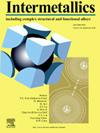高铁含量fe85.5 b13p0.5 5c0.2 cu0.8非晶合金的结晶行为
IF 4.8
2区 材料科学
Q2 CHEMISTRY, PHYSICAL
引用次数: 0
摘要
软磁材料的高饱和磁化强度是电子器件小型化的必要条件。对于铁基非晶纳米软磁材料,Bs越高,铁含量越高。然而,铁的含量受到玻璃化能力和非晶纳米晶结构优化的限制。在本研究中,我们报道了高铁含量合金(Fe86-xB12.5+ xp0.5 5c0.2 cu0.8 (x = 0.5, 1,1.5 at))中非晶纳米晶结构的形成。%)由单辊熔融纺丝和易于热处理。x射线衍射(XRD)和差示扫描量热仪(DSC)分析表明,非晶态fe85.5 b13p0.5 5c0.2 cu0.8合金的结晶温度范围较大,为ΔT = 76 K,在连续加热过程中依次发生非晶态基体→非晶态基体+ α-Fe相→α-Fe + Fe3C + Fe3B相的结晶过程。α-Fe形成的一次结晶与二次结晶之间存在较大的分离,使得非晶纳米软磁微观结构易于优化。结果表明,优化后的双非晶纳米晶结构具有1.8 T的超高Bs。本文章由计算机程序翻译,如有差异,请以英文原文为准。
Crystallization behavior of a high-iron-content Fe85.5B13P0.5C0.2Cu0.8 amorphous alloy
High saturation magnetization (Bs) of soft magnetic materials is essential for the miniaturization of electronic devices. For Fe-based amorphous-nanocrystalline soft magnetic materials, higher Bs requires higher iron contents. However, the iron content is restricted by glass forming ability and the optimization of the amorphous-nanocrystalline structure. In this study we report the formation of the amorphous-nanocrystalline structure in a high iron content alloy (Fe86-xB12.5+xP0.5C0.2Cu0.8 (x = 0.5, 1, 1.5 at. %) by a single-roller melt spinning and facile heat treatment. Based on the X-ray diffraction (XRD) and differential scanning calorimeter (DSC), the amorphous Fe85.5B13P0.5C0.2Cu0.8 alloy has a large crystallization temperature range of ΔT = 76 K, and the crystallization process of amorphous matrix → amorphous matrix + α-Fe phase → α-Fe + Fe3C + Fe3B phase takes place in sequence during the continuous heating. The large separation between the primary crystallization with the formation of α-Fe and the secondary crystallization leads to the easy optimization of the amorphous-nanocrystalline soft magnetic microstructure. As a result, the optimized dual amorphous-nanocrystalline structure shows an ultrahigh Bs of 1.8 T.
求助全文
通过发布文献求助,成功后即可免费获取论文全文。
去求助
来源期刊

Intermetallics
工程技术-材料科学:综合
CiteScore
7.80
自引率
9.10%
发文量
291
审稿时长
37 days
期刊介绍:
This journal is a platform for publishing innovative research and overviews for advancing our understanding of the structure, property, and functionality of complex metallic alloys, including intermetallics, metallic glasses, and high entropy alloys.
The journal reports the science and engineering of metallic materials in the following aspects:
Theories and experiments which address the relationship between property and structure in all length scales.
Physical modeling and numerical simulations which provide a comprehensive understanding of experimental observations.
Stimulated methodologies to characterize the structure and chemistry of materials that correlate the properties.
Technological applications resulting from the understanding of property-structure relationship in materials.
Novel and cutting-edge results warranting rapid communication.
The journal also publishes special issues on selected topics and overviews by invitation only.
 求助内容:
求助内容: 应助结果提醒方式:
应助结果提醒方式:


